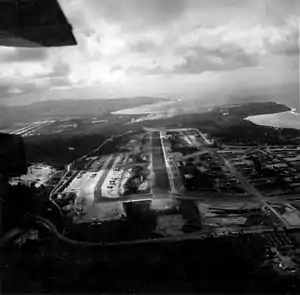Harmon Air Force Base
Harmon Air Force Base is a former World War II United States Army Air Forces airfield, and postwar United States Air Force Base on Guam in the Mariana Islands. Originally named "Depot Field", it was renamed in honor of Lieutenant General Millard F. Harmon, who disappeared on 26 February 1945 on a flight from Kwajalein to Hawaii. Despite the most intensive search by Army and Navy planes and surface vessels, no trace of the plane was ever found. On February 25, 1946, he was declared officially dead.
| Harmon Air Force Base Depot Field .png.webp) | |
|---|---|
| Part of Twentieth Air Force (FEAF) | |
 Harmon Field, Guam, January 1945 | |
| Coordinates | 13°30′0″N 144°48′30″E |
| Type | Military airfield |
| Site information | |
| Controlled by | United States Army Air Forces United States Air Force |
| Site history | |
| Built | 1944 |
| In use | 1944–1949 |
History
Harmon Field was the headquarters for the XXI Bomber Command and later Twentieth Air Force which directed the B-29 Superfortress strategic bombing campaign against the Japanese Home Islands. It was also the major B-29 aircraft depot and maintenance facility in the Western Pacific during the war, and that mission continued for Far East Air Forces until its closure.
Harmon was used operationally by the USAF 11th Bombardment Group as an operational B-29 Base. After the war the 9th Bombardment Group used the base for strategic reconnaissance missions and the 374th Troop Carrier Group of the Technical Service Command used the base for transport of supplies and equipment from its depot facilities. Harmon AFB was closed in 1949 due to budget constraints[1] and was merged with the neighboring Naval Air Station Agana.
Today, the technical facilities are an industrial area to the northeast of the Antonio B. Won Pat International Airport, which served as the main airfield for both Harmon AFB and NAS Agana.
Major units assigned
- 1537th Army Air Forces Base Unit, 30 September 1944 – 1 August 1945
- 75th Air Service Group, 1 May 1947 – 20 September 1948
- 367th Air Service Group, 1 May 1947 – 1 November 1949
- Guam Air Depot (later Guam Air Materiel Area, Marianas Air Materiel Area)
- 56th Air Depot Group, Air Technical Service Command, 9 November 1944 – 31 August 1945
- 24th Air Depot Group, Air Technical Service Command, 8 November 1944 – 1 July 1949
- 55th Air Depot Group, Air Technical Service Command, 1 January 1945 – 21 December 1945
- 25th Air Depot Group, Air Technical Service Command, 21 January 1945 – 1 November 1949
- XXI Bomber Command, 4 December 1944 – 16 July 1945
- Twentieth Air Force, 16 July 1945 – 16 May 1949
- Western Pacific Wing, Air Transport Command, 10 April 1946 – 1 March 1947
- 11th Bombardment Group (Very Heavy), 15 May 1946 – 20 October 1948
- 9th Bombardment Group (Very Heavy), 9 June 1947 – 20 October 1948
- 374th Troop Carrier Group, 1 April 1947 – 5 March 1949
- 3d Reconnaissance Squadron (Very Long Range, Photographic), 11 January 1945 – 15 March 1947
References
- Maurer, Maurer (1983). Air Force Combat Units of World War II. "Maxwell AFB, Alabama": Office of Air Force History. ISBN 0-89201-092-4.
![]() This article incorporates public domain material from the Air Force Historical Research Agency website http://www.afhra.af.mil/.
This article incorporates public domain material from the Air Force Historical Research Agency website http://www.afhra.af.mil/.
- Shearon, Bernie. "Guam Air Depot". Retrieved 31 January 2013.